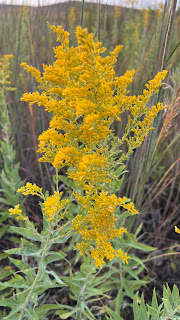 |
| Tall Goldenrod |
.jpg) So consider this a short tour of the ditches alongside the road. Of course, this time of year, Goldenrod is everywhere. My plant identification is suspect as always, especially here given the number of native Goldenrods, but I believe the photos above and left are of Tall Goldenrod, Solidago altissima, although it could be Canadian Goldenrod, the former being a subspecies of the latter.
So consider this a short tour of the ditches alongside the road. Of course, this time of year, Goldenrod is everywhere. My plant identification is suspect as always, especially here given the number of native Goldenrods, but I believe the photos above and left are of Tall Goldenrod, Solidago altissima, although it could be Canadian Goldenrod, the former being a subspecies of the latter.
Heliathus annuus. I'm not anywhere near certain of the species name for this specimen, and I wouldn't have a clue at all without the marvelous kswildflower.org website.
.jpg) There is a lot of White Sage, Artemsia ludoviciana. on the walk, everywhere in the adjacent prairie, its hairy-gray leaves befitting a plant adapted to drought and grazing.
There is a lot of White Sage, Artemsia ludoviciana. on the walk, everywhere in the adjacent prairie, its hairy-gray leaves befitting a plant adapted to drought and grazing.
Brickellia eupatoriopiodes, or False Boneset, is likewise a very frequent visitor to these hills, blooming in the worst of drought and leaving behind an interesting winter skeleton. It's taproot is said to reach 16 feet in depth when necessary.
.jpg) Nearly last, but certainly not least, clumps of the the most "garden-worthy" of the prairie plants, Dotted Gayfeather, Liatris punctata, "dots" the prairie with low light purple spires. Butterflies love this plant, and often are above it in a swarm.
Nearly last, but certainly not least, clumps of the the most "garden-worthy" of the prairie plants, Dotted Gayfeather, Liatris punctata, "dots" the prairie with low light purple spires. Butterflies love this plant, and often are above it in a swarm. .jpg)
.jpg) |
| Wax Goldenweed |
And that is a walk down my late-September road everyone. Not as literary-worthy as Bill Bryson's A Walk in the Woods, but its none-the-less my own little "Walk Down the Road with Bella."
.jpg)
.jpg)
.jpg)
.jpg)
.jpg)
.jpg)
.jpg)
.jpg)
Your wildflowers are really impressive, they are so different from the ones we have in Australia. I have never seen goldenrod, but hear it is good for beekeeping.
ReplyDeleteI had never heard of Dotted Gayfeather (Liatris punctata), it looks incredible. I will have to see if it is available in Australia. Do you know if it is difficult to grow in cultivation? Some Australian wild flowers (eg flying duck orchid) only grow in the wild and are never seen in gardens.